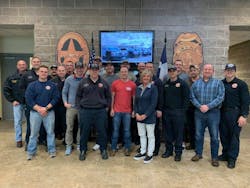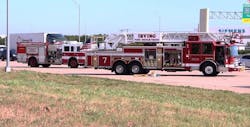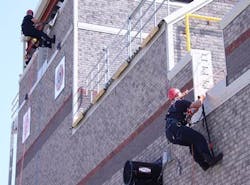Through “Chief’s Corner,” Firehouse Magazine speaks with fire chiefs across the country to better understand today’s leadership challenges and to bring leadership ideas to our readers. For this edition, we spoke with Victor Conley, who is the fire chief of the Irving, TX, Fire Department (IFD).
FIREHOUSE: The IFD was awarded Best Practices Recognition by the Texas Fire Chiefs Association. What are some of the achievements that lead to that recognition?
CONLEY: The Texas Fire Chiefs Association Best Practices Recognition is an inward review on policies, procedures and processes.
There is a need to continue the day-to-day practices without any specific individual being present with the department. The review process allows fire chiefs throughout the state of Texas to come in and scrutinize more than 100 points of interests. Some of the items include the risk management program, the fire department master plan, the strategic plan and even a succession plan. The Irving Fire Department trailblazed this process, as we were the first in the state of Texas to complete the process in 2014 and even be re-recognized a few years later.
FIREHOUSE: Over the past few years, you and your department received a lot of attention for the Blocker Unit program. What are the next steps?
CONLEY: We have received a lot of recognition for this program. I have sent information on how other entities can start this program within their own community and jurisdiction.
This is a never-ending process. What I mean by that is, our emergency responses continue to change with technology and the ongoing lack of attention drivers devote to their automobiles. We recently went back to the drawing board and updated our policy for working on these dangerous thoroughfares because of an incident where one of our firefighters was hit by an automobile traveling in the wrong direction.
CONLEY: This classification is based on three main components: water, communications and the fire department. Irving was maxed out on two of the three, so the fire department was the only area the city needed to improve on. We were able to increase our scores with Fire Station 12 [opened in August 2017], the addition of a fifth ladder truck, proper distribution of the ladder trucks and, finally, the drill facility that we partnered with a neighboring city to complete.
FIREHOUSE: Although Irving is landlocked, the city has grown, and you added firefighters and stations. What was needed to grow your public safety offerings to the community?
CONLEY: Data! We completed a national response study, and with those findings we were able to identify gaps in our response coverage. Fire Station 12 closed the largest gap, and the upcoming Central Fire Station will close the second largest gap. In addition, our EMS responses continue to increase with our population, which demands this high-quality service.
The hardest staffing to increase has been, and continues to be, four-firefighter staffing. Most all cities around us have some level of four-firefighter staffing. We continue to educate, collect data and request the addition of this staffing for the safety and more effective and efficient service of our emergency responses.
FIREHOUSE: What are some of the IFD’s unique community risk reduction (CRR) programs based on the diverse population and response needs of your residents?
CONLEY: As with most departments, our community seems to continue to have the risk of slips and falls of our elderly along with cooking fires. The challenges have been how to communicate with our diverse cultures within our city.
In addition, we implemented an emergency operations plan review process with assigned fire prevention personnel for our corporate partners, with a focus on multistoried buildings and facilities with limited-mobile patients.
We currently have a CRR team that covers public education, public information and community risk messages. In addition, we are fortunate to have a broadcast station within our community along with very active churches and community leaders that help us communicate our message. We try to tap into all available resources to make our city safer.
FIREHOUSE: What goals are you looking to implement in 2021 and beyond?
CONLEY: Our goal continues to focus on the safety of our personnel and our community. We continue to assess and analyze our key performance indicators and measurements to see how we can become more efficient and effective as a service to our community. This includes, but is not limited to, personnel, policies and resources.
Our newest program to implement is the peer-to-peer program. We partner with our police department and share resources both within and outside of our city.
We also continue to promote awareness, prevention and education regarding cancers within our profession. We have a 501(c)(3) nonprofit organization, called Gray Matter to Firefighters, where we share a lot of information with community leaders and other fire departments and raise revenue to donate straight to research through University of Texas Southwestern Medical Center.
FIREHOUSE: What do you consider being a successful fire chief?
CONLEY: That’s a loaded question … Foremost, the safety and morale of our firefighters, and, secondly, maintaining the budget from a management perspective.
Staying humble, always reflecting on what I can do better, trying to think outside of the box to improve safety, effectiveness and efficiency.
I encourage our personnel to invest in themselves, because it makes our department better. Expectation is set from the day a firefighter is hired to give back to the community that has given them an awesome career by volunteering.
I was asked one time, “What keeps you up at night?” My response was, and still is, “What is it that I am missing? How can I make our department safer and better?”
FIREHOUSE: What is the one thing that you know now that you wish that you knew before you became a fire chief or joined the fire service?
CONLEY: A song that Garth Brooks sings, called “The Dance,” says it best: I am glad I didn’t know the way it all would go. Our lives are better left to chance. I could have missed the pain, but I would’ve had to miss the dance.
The reason these words are so appropriate is if I knew our profession could inflict destruction on the body like we have discovered through cancer and post-traumatic stress I may have been a football coach.
I do impress this on our new firefighters, so they can make an educated decision on their career.
FIREHOUSE: Irving boasts one of the most diverse zip codes in the United States. What steps did your department take to connect and engage with residents when it comes to community risk and on emergency calls? What challenges did you face, and from what successes can other departments benefit?
CONLEY: The city of Irving is a very diverse city and one of our publicity points is a zip code within our city limits that carries the title of “the most diverse” in the United States. While this is certainly a positive aspect of our community, it does create some challenges for emergency response calls for service. We have taken on several ways to close the communication gap with our diverse community. From a prevention standpoint, our Public Education Department is developing a plan for community risk reduction specific to certain census tracts and packaging that information so the community can understand and implement the message into their culture. We also proactively develop relationships, on a regular basis, with our community by attending events hosted by our diverse community, providing medical and fire protection standby for a multitude of cultural events throughout our city and participating in face-to-face engagements, such as National Night Out, BAPS Shri Swaminarayan Mandir activities, Ramadan events and interactions, and many Hispanic festivities, etc. These are some of the ways of getting to know our multicultural community. Our employees are also expected to attend diversity and inclusion training, and the city offers an incentive to receive a second-language pay. In addition to being proactive, we also subscribe to a national language line database, and we have medical devices that have the capability of asking basic questions in a multitude of languages and interpreting the response into English.
FIREHOUSE: What roles does your PIO play in the community, and how have they grown the department’s reputation in the city?
CONLEY: The goal for our PIO is to push out timely and accurate information to the public through media sources and social media platforms. We believe that without representation from our fire department, the media and others are at liberty to tell our story concerning a fire, rescue, medical call or even the basic humanitarian interactions from our firefighters to the community based on [the media’s and others’ perspectives]. The PIO should carry a strong subject-matter-expert reputation with area media outlets, be capable of delivering an easily understood message and capitalize on the opportunity to deliver a safety message. Reputation is a difficult thing to build, but it is extremely easy to destroy. Our PIO has done an excellent job building our reputation in the community and elevating the city’s message throughout the region. We recently teamed our PIO up with our public educator and community risk reduction officer. The team complements one another, and we believe they will have a synergistic effect on our community.
FIREHOUSE: Your department hired several returning veterans. What process do they go through to get hired, and what resources do you make available for them?
CONLEY: The city of Irving falls under the Texas Local Government Code Chapter 143—Municipal Civil Service. What this means is, by law, the only privilege we can extend to military personnel is a five-point bonus on their entrance examination if they were honorably discharged and have the DD Form 214 to present at examination. Other than the bonus points, the military applicants go through the same hiring regimen as all other applicants. Once a military reservist is hired, Irving goes above and beyond the USERRA (U.S. Employment and Reemployment Rights Act) federal statute in honoring the commitment these young men and women have made to our country. Having said that, here at Irving Fire Department, we are proud to say approximately 25 percent of our 385-member department served [in the armed forces] or is currently serving in a branch of the military reserves.
FIREHOUSE: Regarding your shared fire training facility and how that came to fruition: How do you ensure that each agency gets enough time to train, and do you train together as mutual aid partners?
CONLEY: In 2006, the citizens of Irving voted to support a bond package that included a drill facility for the fire department. Long story short, a new city manager was hired in 2014, and part of the capital improvement plan was to construct the drill facility for the fire department. Unfortunately, construction costs had way exceeded the allotted bond dollars allocated for this project. I had a good rapport with Chief Robert Fite of Grand Prairie Fire Department, and after a short discussion, we agreed to pursue this training facility as a joint effort. The beauty of this idea was it would reduce each city’s liability by 50 percent, and, in return, we were both able to reach a goal of becoming an ISO 1 city. So, selling the idea to our city managers was the easy part; however, creating an interlocal agreement and designing a facility that met the needs of two large metropolitan cities with various response capabilities was more challenging. In the end, we got a grandiose facility that meets our current needs, and we continue to expand the facility’s capabilities annually. For example, Grand Prairie was able to get a Firefighter Air Replenishment System (FARS) donated and installed, and Irving Fire Department personnel constructed a Class A burn building on the premises.
Scheduling has been a smooth and coordinated effort by both departments’ training staff. The current schedule is one week on and one week off unless the city that is up has nothing scheduled, then it is a first come, first served for each city, i.e., Grand Prairie may schedule the trench rescue prop, while Irving utilizes the burn tower. We already respond on mutual aid calls to the city in need, so the joint drill facility has only enhanced and solidified our relationship.
FIREHOUSE: Irving is known to have a good support system for its firefighters. Explain the Critical Incident Stress Management (CISM) team and its role to assist any members who need a place to turn?
CONLEY: We have an exceptional support team for both fire and police here in the city of Irving. Like most cities, we started out with the CISM team as a defusing/debriefing interaction as needed. However, this concept has mutated into a full-blown peer-to-peer support network for fire and police. In addition to this, we recently received the governing body’s support, along with management, to implement a new concept. Starting this fiscal year, we will have a 24/7/365 Wellness Team available for all first responders. A doctor of psychiatry will be over the program, which functionally reports to both fire and police, and two clinicians will answer to the doctor, and each clinician will have a peer-to-peer team reporting to them, one fire and the other police. The Wellness Team will have their own budget and facility away from any other city facility, to help protect confidentiality and instill confidence within our fire and police personnel. We believe this is how mental health support should and will be built in the future.
FIREHOUSE: What is one piece of advice that you have for the next generation of fire service leaders?
CONLEY: Unfortunately, I cannot narrow it down to one.
The fire service is the one profession that still carries trust and respect in our communities, and we should always protect and safeguard that confidence. Never become complacent, and always strive to improve yourself, as well as those around you, and, ultimately, the department will improve.
I have found that helping others to achieve their goals within the fire service is most fulfilling. Do not fear others’ knowledge or expertise but rather embrace them, to make our fire service better than you found it.
The three quotes I have used over the years are: “If you are afraid of backing up, you will never move forward”; “Leave it better than you found it,” and; “The best leaders know when to get out of the way.”
And finally, my words to live by are, Have Fun, Get S**t Done (HFGSD)!
About the Author
Firehouse Staff
Content written and created by Firehouse Magazine editors.


